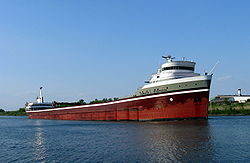
Straight decker
Encyclopedia

Ship
Since the end of the age of sail a ship has been any large buoyant marine vessel. Ships are generally distinguished from boats based on size and cargo or passenger capacity. Ships are used on lakes, seas, and rivers for a variety of activities, such as the transport of people or goods, fishing,...
built with its pilothouse
Pilothouse
A pilothouse or pilot-house is a glass-enclosed room from which a ship is controlled by the ship's pilot. The pilothouse also is known as the wheelhouse....
forward and engines aft
Aft
Aft, in naval terminology, is an adjective or adverb meaning, towards the stern of the ship, when the frame of reference is within the ship. Example: "Able Seaman Smith; lay aft!". Or; "What's happening aft?"...
to provide continuous hold between. This design originated to meet the navigational demands on lake freighter
Lake freighter
Lake freighters, or Lakers, are bulk carrier vessels that ply the Great Lakes. The best known was the , the most recent and largest major vessel to be wrecked on the Lakes. These vessels are traditionally called boats, although classified as ships. In the mid-20th century, 300 lakers worked the...
s on the U.S./Canadian Great Lakes
Great Lakes
The Great Lakes are a collection of freshwater lakes located in northeastern North America, on the Canada – United States border. Consisting of Lakes Superior, Michigan, Huron, Erie, and Ontario, they form the largest group of freshwater lakes on Earth by total surface, coming in second by volume...
routes. The term "Straight Decker" is commonly used upon the Great Lakes to denote a bulk/ore freighter which has not been equipped with self-unloading machinery.
Straight Deckers are mainly owned by the Canadian fleets, such as Upper Lakes Shipping (ULS). One exception can be made, though. The U.S. freighter Edward L. Ryerson came out of long term layup, and joined the fleet once again in 2006. Straight deckers are loaded and unloaded by gantry crane
Gantry crane
Gantry cranes, bridge cranes, and overhead cranes, are all types of cranes which lift objects by a hoist which is fitted in a hoist trolley and can move horizontally on a rail or pair of rails fitted under a beam...
s or Hulett
Hulett
The Hulett automatic ore unloader was invented by George Hulett of Ohio in the late 19th century; he received a patent for his invention in 1898. The first working machine was built the following year at Conneaut Harbor in Conneaut, Ohio...
Unloaders. These giants used a clamshell bucket and counterweight system to scoop the cargo out of the holds, one load at a time.



